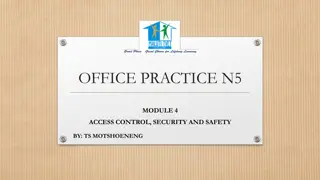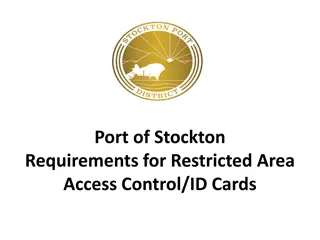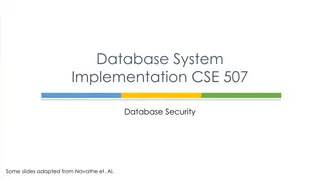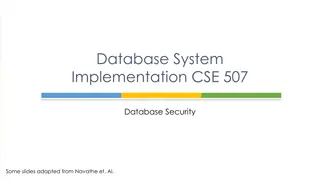Access Control and Security Equipment Overview
Types of access control systems including code-based, proximity, and biometric methods for secure entry into buildings and restricted areas. Learn about the benefits and uses of finger/palm print scanners, electronic locking devices, and detection equipment like metal detectors and X-ray scanners.
Download Presentation

Please find below an Image/Link to download the presentation.
The content on the website is provided AS IS for your information and personal use only. It may not be sold, licensed, or shared on other websites without obtaining consent from the author.If you encounter any issues during the download, it is possible that the publisher has removed the file from their server.
You are allowed to download the files provided on this website for personal or commercial use, subject to the condition that they are used lawfully. All files are the property of their respective owners.
The content on the website is provided AS IS for your information and personal use only. It may not be sold, licensed, or shared on other websites without obtaining consent from the author.
E N D
Presentation Transcript
OFFICE PRACTICE N5 MALUTI TVET BETHLEHEM J CASTELYN
TOPIC 4: ACCESS CONTROL, SECURITY AND SAFETY 4. SCANNING EQUIPMENT 4.1 TYPES, PURPOSE AND USES
4.1 TYPES, PURPOSE AND USES Code base access system type in private pin number. Compare pin with number captured on system. If correct access is allowed. Proximity access control Identification/ key/ electronic building access card are used to gain access. Swiped or shown to reader. If cannot be read or recognise the card, access denied. The reader can indicate if card was tampered with. Biometric access control The technique refers to the way in which unique human characteristics are used for positive identification. Use of retina / iris (eye scanner), finger/palm print (-scanner) and/or voice recognition as access control. Camera capture the image, a microphone the voice, a small scanner device the print. Automatic recognition. Easily identify people not allowed to access certain areas.
Finger/palm print scanner BENEFITS: Ideal method for identification for access control because not two persons fingerprints are the same. Quick and easy monitoring system Makes administration easier Environmentally friendly as it uses no paper. USES: Control access into buildings and restricted areas Monitor staff movements Log times worked Log and track attendance at colleges and schools and staff on an organisation s system Automate a library system Make cashless payments Verify someone s identity to prevent identity theft, illegal immigration and terrorism
4.1 TYPES, PURPOSE AND USES Electronic locking device Mechanisms installed to open a door/gate when access card is swiped or numbers punched into key pad. If the reader cannot recognise or read the card, access denied. Can indicate if card was tampered with. Combination lock access to walk-in safes, filing cabinets or lockers. Turn the dial on the door according to a numerical code or entering correct numbers on a keypad will open the lock. Locks can be combined with electronic devices and then programmed via computers or other technological devices. Numerous attempts to turn the dial without getting it right will raise suspicion and alert security.
Detecting fire arms, dangerous weapons or bombs WALK-THROUGH METAL DETECTOR: Will determine whether a person is carrying any kind of metal articles. Should a person carry any metal on him/her, the detector will sound and alarm. It is often used as control of internal staff to monitor what they carry in and out of the building. HAND METAL DETECTOR: Is hand operated by security personnel, by moving it over the body and bag of the visitor or employee. The device will signal when it detects any kind of metal or electric article, e.g. A gun, cell phone etc. The person will then have to prove that the article is safe. X-RAY SCANNER: Will scan all parcels, handbags, briefcases, etc. For their contents. This type of scanner is used in conjunction with the metal detector. All bags, cameras, luggage, cameras etc. Must go through the X-ray scanner while people go through the metal detector. The X-ray scanner shows the total contents of the luggage on a screen, which is monitored by a security officer. This method is expensive but highly effective because everything in the luggage and handbag can be seen in detail.























